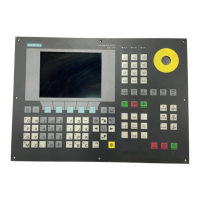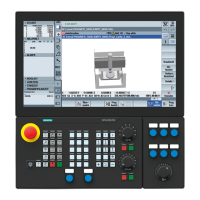Tool offsets
7.6 Tool orientation (ORIC, ORID, OSOF, OSC, OSS, OSSE, ORIS, OSD, OST)
Job planning
424 Programming Manual, 07/2010, 6FC5398-2BP40-0BA0
Programming
Programming a orientation change:
A change in tool orientation can be programmed by:
● Direct programming of rotary axes
A, B, C (rotary axis interpolation)
● Euler or RPY angle
● Direction vector (vector interpolation by specifying
A3 or B3 or C3)
●
LEAD/TILT (face milling)
The reference coordinate system is either the machine coordinate system (
ORIMKS) or the
current workpiece coordinate system (
ORIWKS).
2ULHQWDWLRQ
FKDQJH
Programming tool orientation:
Command Significance
ORIC: Orientation and path movement in parallel
ORID: Orientation and path movement consecutively
OSOF: No orientation smoothing
OSC: Orientation constantly
OSS: Orientation smoothing only at beginning of block
OSSE: Orientation smoothing at beginning and end of block
ORIS: Velocity of the orientation change with orientation smoothing activated in
degrees per mm (valid for
OSS and OSSE)
OSD: Smoothing of orientation by specifying smoothing distance with setting data:
SD42674 $SC_ORI_SMOOTH_DIST
OST: Smoothing of orientation by specifying angular tolerance in degrees for
vector interpolation with setting data:
SD42676 $SC_ORI_SMOOTH_TOL
With rotary axis interpolation, the specified tolerance is assumed to be the
maximum variance of the orientation axes.

